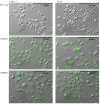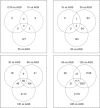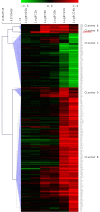Interleukin-8 is the single most up-regulated gene in whole genome profiling of H. pylori exposed gastric epithelial cells
- PMID: 22248188
- PMCID: PMC3292955
- DOI: 10.1186/1471-2180-12-9
Interleukin-8 is the single most up-regulated gene in whole genome profiling of H. pylori exposed gastric epithelial cells
Abstract
Background: The association between Helicobacter pylori infection and upper gastrointestinal disease is well established. However, only a small fraction of H. pylori carriers develop disease, and there are great geographical differences in disease penetrance. The explanation to this enigma lies in the interaction between the bacterium and the host. H. pylori Outer Membrane Phospholipase A (OMPLA) has been suggested to play a role in the virulence of this bacterium. The aim of this study was to profile the most significant cellular pathways and biological processes affected in gastric epithelial cells during 24 h of H. pylori exposure, and to study the inflammatory response to OMPLA⁺ and OMPLA⁻ H. pylori variants.
Results: Interleukin-8 was the most significantly up-regulated gene and appears to play a paramount role in the epithelial cell response to H. pylori infection and in the pathological processes leading to gastric disease. MAPK and NF-kappaB cellular pathways were powerfully activated, but did not seem to explain the impressive IL-8 response. There was marked up-regulation of TP53BP2, whose corresponding protein ASPP2 may interact with H. pylori CagA and cause marked p53 suppression of apoptosis. Other regulators of apoptosis also showed abberant regulation. We also identified up-regulation of several oncogenes and down-regulation of tumor suppressor genes as early as during the first 24 h of infection. H. pylori OMPLA phase variation did not seem to influence the inflammatory epithelial cell gene response in this experiment.
Conclusion: In whole genome analysis of the epithelial response to H. pylori exposure, IL-8 demonstrated the most marked up-regulation, and was involved in many of the most important cellular response processes to the infection. There was dysregulation of apoptosis, tumor suppressor genes and oncogenes as early as in the first 24 h of H. pylori infection, which may represent early signs of gastric tumorigenesis. OMPLA⁺/⁻ did not affect the acute inflammatory response to H. pylori.
Figures






Similar articles
-
The Helicobacter pylori autotransporter ImaA (HP0289) modulates the immune response and contributes to host colonization.Infect Immun. 2012 Jul;80(7):2286-96. doi: 10.1128/IAI.00312-12. Epub 2012 May 7. Infect Immun. 2012. PMID: 22566509 Free PMC article.
-
Helicobacter pylori outer membrane protein HopQ identified as a novel T4SS-associated virulence factor.Cell Microbiol. 2013 Nov;15(11):1896-912. doi: 10.1111/cmi.12158. Epub 2013 Jul 15. Cell Microbiol. 2013. PMID: 23782461 Free PMC article.
-
Helicobacter pylori antigen HP0986 (TieA) interacts with cultured gastric epithelial cells and induces IL8 secretion via NF-κB mediated pathway.Helicobacter. 2014 Feb;19(1):26-36. doi: 10.1111/hel.12100. Epub 2013 Oct 31. Helicobacter. 2014. PMID: 24205801
-
Virulence of Helicobacter pylori outer membrane proteins: an updated review.Eur J Clin Microbiol Infect Dis. 2020 Oct;39(10):1821-1830. doi: 10.1007/s10096-020-03948-y. Epub 2020 Jun 17. Eur J Clin Microbiol Infect Dis. 2020. PMID: 32557327 Free PMC article. Review.
-
Effect of Helicobacter pylori on gastric epithelial cells.World J Gastroenterol. 2014 Sep 28;20(36):12767-80. doi: 10.3748/wjg.v20.i36.12767. World J Gastroenterol. 2014. PMID: 25278677 Free PMC article. Review.
Cited by
-
In Vitro Anti-Inflammatory Activity of Peptides Obtained by Tryptic Shaving of Surface Proteins of Streptococcus thermophilus LMD-9.Foods. 2022 Apr 16;11(8):1157. doi: 10.3390/foods11081157. Foods. 2022. PMID: 35454744 Free PMC article.
-
Helicobacter pylori infection and colorectal carcinoma: is there a causal association?J Gastrointest Oncol. 2012 Dec;3(4):380-5. doi: 10.3978/j.issn.2078-6891.2012.058. J Gastrointest Oncol. 2012. PMID: 23205318 Free PMC article. No abstract available.
-
Sulindac activates NF-κB signaling in colon cancer cells.Cell Commun Signal. 2013 Oct 1;11:73. doi: 10.1186/1478-811X-11-73. Cell Commun Signal. 2013. PMID: 24083678 Free PMC article.
-
Inflammation, DNA Damage, Helicobacter pylori and Gastric Tumorigenesis.Front Genet. 2017 Feb 27;8:20. doi: 10.3389/fgene.2017.00020. eCollection 2017. Front Genet. 2017. PMID: 28289428 Free PMC article. Review.
-
The Helicobacter pylori infection alters the intercellular junctions on the pancreas of gerbils (Meriones unguiculatus).World J Microbiol Biotechnol. 2024 Jul 20;40(9):273. doi: 10.1007/s11274-024-04081-0. World J Microbiol Biotechnol. 2024. PMID: 39030443 Free PMC article.
References
-
- Calvino FM, Parra CT. H. pylori and mitochondrial changes in epithelial cells. The role of oxidative stress. Rev Esp Enferm Dig. 2010;102:41–50. - PubMed
Publication types
MeSH terms
Substances
LinkOut - more resources
Full Text Sources
Research Materials
Miscellaneous

